Grizzly G0574 User Manual

MANUAL INSERT
Model G0574
Radiusing Sander
INTRODUCTION
The Model G0574 Radiusing Sander is based on the Model G1140 Edge Sander with the addition of the radiusing attachment. Refer to the G1140 Edge Sander manual for the sanding unit assembly instructions and refer to the included G0577 Radiusing Attachment manual for radiusing attachment installation instructions. The Model G0574 DOES NOT include the work table, auxiliary table, and miter body listed in the manual of the G1140. These parts are unnecessary when the radiusing attachment is installed. The inventory for the G0574 is as follows:
Model G0574 Parts:
Figure 1. Model G0574.
• |
Sanding Unit............................................... |
1 |
• |
Quick Release Lever.................................. |
1 |
• |
Dust Port .................................................... |
1 |
• 6'' X 80'' Sanding Belt ................................ |
1 |
|
• |
Back Stop................................................... |
1 |
• |
Feet ............................................................ |
4 |
• |
Long Support Bracket ................................ |
1 |
• |
Short Support Bracket................................ |
1 |
• |
Guide Rail A............................................... |
2 |
• |
Guide Rail B............................................... |
4 |
• Radius Control Swing Arm Assembly ........ |
1 |
|
• |
Horizontal Adjustment Tubes ..................... |
2 |
• |
Locking Plate A .......................................... |
2 |
• |
Locking Plate B .......................................... |
4 |
• |
Brace.......................................................... |
1 |
• |
Height Adjustment Arms ............................ |
2 |
• |
Idler Roller Cover ....................................... |
1 |
Model G0574 Hardware Bag: |
|
—Shim ....................................................... |
1 |
—Hex Bolt 5⁄16"-18 x 2½"............................. |
3 |
—Hex Bolt 3⁄8"-16 x 1"................................. |
3 |
—Flat Washer 3⁄8"...................................... |
11 |
—Flat Washer 5⁄16"...................................... |
6 |
—Hex Nut 5⁄16"-18 ....................................... |
3 |
—Hex Bolt 3⁄8"-16 x 2 .................................. |
2 |
—Hex Nut 3⁄8"-16......................................... |
2 |
—7⁄32" Hex Wrench...................................... |
1 |
—12-14mm Open End Wrench................... |
1 |
—2mm Hex Wrench................................... |
1 |
—Phillips® Hd Screw 10-24 X 3/4''............. |
4 |
NOTICE
When ordering parts for the Model G0574 Radiusing Sander, refer to the G1140 manual for sanding unit components, and refer to the G0577 manual for radiusing attachment components.
COPYRIGHT © MAY, 2005. BY GRIZZLY INDUSTRIAL, INC.
WARNING: NO PORTION OF THIS MANUAL MAY BE REPRODUCED IN ANY SHAPE OR FORM WITHOUT THE WRITTEN APPROVAL OF GRIZZLY INDUSTRIAL, INC.
#EW7254 PRINTED IN TAIWAN
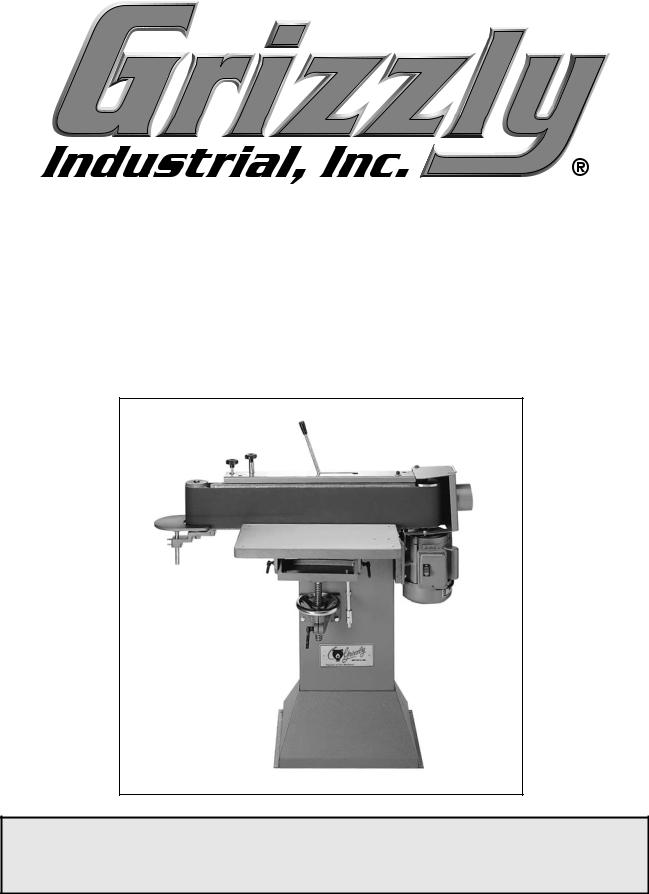
EDGE SANDER
MODEL G1140
INSTRUCTION MANUAL
COPYRIGHT © 1996 BY GRIZZLY INDUSTRIAL, INC.
WARNING: NO PORTION OF THIS MANUAL MAY BE REPRODUCED IN ANY SHAPE OR FORM WITHOUT THE WRITTEN APPROVAL OF GRIZZLY INDUSTRIAL, INC.
REVISED APRIL, 1999. PRINTED IN U.S.A.

|
Table Of Contents |
|
|
|
PAGE |
1. |
SAFETY RULES |
|
|
SAFETY RULES FOR POWER TOOLS ................................................................................ |
1-2 |
|
SAFETY RULES FOR SANDERS ............................................................................................ |
3 |
2. |
CIRCUIT REQUIREMENTS |
|
|
220V/110V OPERATION............................................................................................................ |
4 |
|
CIRCUIT LOAD .......................................................................................................................... |
4 |
|
GROUNDING ............................................................................................................................ |
4 |
|
EXTENSION CORDS ................................................................................................................ |
5 |
|
WIRING DIAGRAM .................................................................................................................... |
5 |
3. |
GENERAL INFORMATION |
|
|
COMMENTARY.......................................................................................................................... |
6 |
|
UNPACKING .............................................................................................................................. |
7 |
|
PIECE INVENTORY .................................................................................................................. |
7 |
|
CLEAN UP.................................................................................................................................. |
8 |
|
SITE CONSIDERATIONS ........................................................................................................ |
8 |
4. |
ASSEMBLY |
|
|
BEGINNING ASSEMBLY .......................................................................................................... |
9 |
|
FEET .......................................................................................................................................... |
9 |
|
WORKING TABLE .............................................................................................................. |
10-11 |
|
MITER BODY .......................................................................................................................... |
12 |
|
QUICK RELEASE LEVER........................................................................................................ |
12 |
|
AUXILIARY TABLE .................................................................................................................. |
13 |
|
DUST HOOD ............................................................................................................................ |
13 |
|
BACK STOP ............................................................................................................................ |
14 |
|
BELT INSTALLATION .............................................................................................................. |
14 |
5. |
ADJUSTMENTS |
|
|
BELT TRACKING .................................................................................................................... |
15 |
|
AUXILIARY TABLE .................................................................................................................. |
15 |
|
TABLE TILT.............................................................................................................................. |
16 |
|
TABLE HEIGHT........................................................................................................................ |
16 |
|
PLATEN TILT .......................................................................................................................... |
17 |
|
BELT TENSION........................................................................................................................ |
17 |
6. |
OPERATIONS |
|
|
TEST RUN................................................................................................................................ |
18 |
|
EDGE & END SANDING.......................................................................................................... |
18 |
|
HORIZONTAL SANDING ........................................................................................................ |
19 |
|
CONTOUR SANDING .............................................................................................................. |
19 |
7. |
MAINTENANCE |
|
|
GENERAL ................................................................................................................................ |
20 |
|
LUBRICATION ........................................................................................................................ |
20 |
|
TABLE ...................................................................................................................................... |
21 |
8. |
CLOSURE...................................................................................................................................... |
21 |
MACHINE DATA .................................................................................................................................... |
22 |
|
WIRING DIAGRAM ................................................................................................................................ |
23 |
|
PART BREAKDOWN ............................................................................................................................ |
24 |
|
PART LISTS .......................................................................................................................................... |
25 |
|
WARRANTY AND RETURNS................................................................................................................ |
26 |
|
G1140 Edge Sander |
-C- |
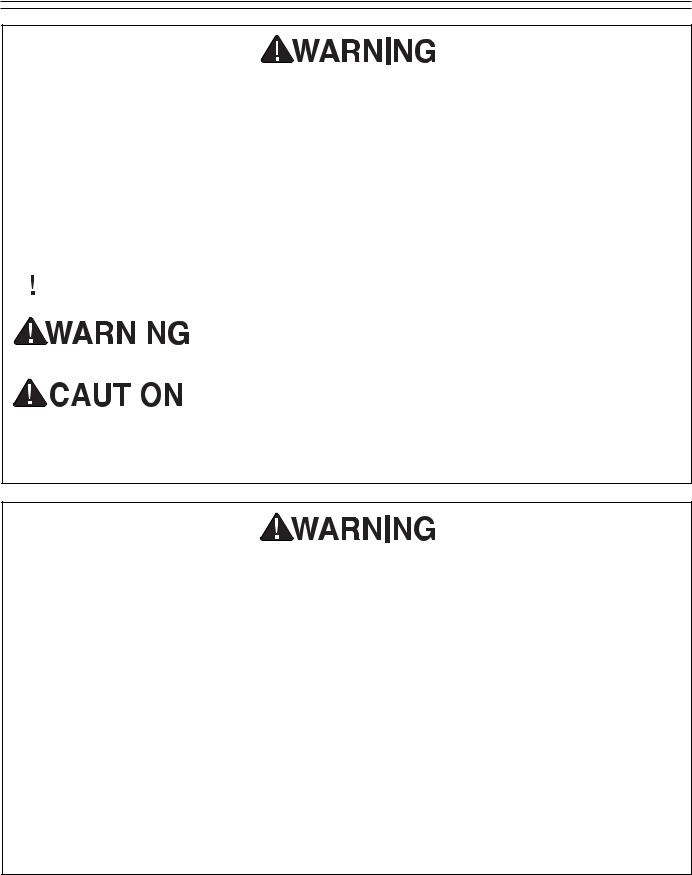
SECTION 1: SAFETY
For Your Own Safety Read Instruction Manual Before Operating This Equipment
The purpose of safety symbols is to attract your attention to possible hazardous conditions. This manual uses a series of symbols and signal words which are intended to convey the level of importance of the safety messages. The progression of symbols is described below. Remember that safety messages by themselves do not eliminate danger and are not a substitute for proper accident prevention measures.
|
|
|
|
|
|
|
|
Indicates an imminently hazardous situation which, if not |
|
|
|
|
|
|
|
|
avoided, WILL result in death or serious injury. |
|
|
|
|
|
|
|
|
Indicates a potentially hazardous situation which, if not |
|
|
|
|
|
|
|
|
|
|
|
|
|
|
|
|
|
|
|
|
|
|
|
|
|
|
avoided, COULD result in death or serious injury. |
|
|
|
|
|
|
|
|
|
|
|
|
|
|
|
|
|
Indicates a potentially hazardous situation which, if not |
|
|
|
|
|
|
|
||
|
|
|
|
|
|
|
|
avoided, MAY result in minor or moderate injury. It may also |
|
|
|
|
|
|
|
|
be used to alert against unsafe practices. |
|
|
|
|
|
|
|
||
|
|
|
|
|
|
|
|
|
|
NOTICE |
|
This symbol is used to alert the user to useful information |
|||||
|
|
about proper operation of the equipment. |
||||||
|
|
|
|
|
|
|
|
|
Safety Instructions For Power Tools
1.KEEP GUARDS IN PLACE and in working order.
2.REMOVE ADJUSTING KEYS AND WRENCHES. Form habit of checking to see that keys and adjusting wrenches are removed from tool before turning on.
3.KEEP WORK AREA CLEAN. Cluttered areas and benches invite accidents.
4.DON’T USE IN DANGEROUS ENVIRONMENT. Don’t use power tools in damp or wet locations, or where any flammable or noxious fumes may exist. Keep work area well lighted.
5.KEEP CHILDREN AND VISITORS AWAY. All children and visitors should be kept a safe distance from work area.
6.MAKE WORK SHOP CHILD PROOF with padlocks, master switches, or by removing starter keys.
7.DON’T FORCE TOOL. It will do the job better and safer at the rate for which it was designed.
8.USE RIGHT TOOL. Don’t force tool or attachment to do a job for which it was not designed.
G1140 Edge Sander |
-1- |

Safety Instructions For Power Tools
9.USE PROPER EXTENSION CORD. Make sure your extension cord is in good condition. Conductor size should be in accordance with the chart below. The amperage rating should be listed on the motor or tool nameplate. An undersized cord will cause a drop in line voltage resulting in loss of power and overheating. Your extension cord must also contain a ground wire and plug pin. Always repair or replace extension cords if they become damaged.
Minimum Gauge for Extension Cords
|
|
LENGTH |
|
||
AMP RATING |
25ft |
|
50ft |
|
100ft |
0-6 |
18 |
|
16 |
|
16 |
7-10 |
18 |
|
16 |
|
14 |
11-12 |
16 |
|
16 |
|
14 |
13-16 |
14 |
|
12 |
|
12 |
17-20 |
12 |
|
12 |
|
10 |
21-30 |
10 |
|
10 |
|
No |
|
|
|
|
|
|
10.WEAR PROPER APPAREL. Do not wear loose clothing, gloves, neckties, rings, bracelets, or other jewelry which may get caught in moving parts. Non-slip footwear is recommended. Wear protective hair covering to contain long hair.
11.ALWAYS USE SAFETY GLASSES. Also use face or dust mask if cutting operation is dusty. Everyday eyeglasses only have impact resistant lenses, they are NOT safety glasses.
12.SECURE WORK. Use clamps or a vise to hold work when practical. It’s safer than using your hand and frees both hands to operate tool.
13.DON’T OVERREACH. Keep proper footing and balance at all times.
14.MAINTAIN TOOLS WITH CARE. Keep tools sharp and clean for best and safest performance. Follow instructions for lubricating and changing accessories.
15.DISCONNECT TOOLS before servicing and changing accessories, such as blades, bits, cutters, and the like.
16.REDUCE THE RISK OF UNINTENTIONAL STARTING. Make sure switch is in off position before plugging in.
17.USE RECOMMENDED ACCESSORIES.
Consult the owner’s manual for recommended accessories. The use of improper accessories may cause risk of injury.
18.CHECK DAMAGED PARTS. Before further use of the tool, a guard or other part that is damaged should be carefully checked to determine that it will operate properly and perform its intended function. Check for alignment of moving parts, binding of moving parts, breakage of parts, mounting, and any other conditions that may affect its operation. A guard or other part that is damaged should be properly repaired or replaced.
19.NEVER LEAVE TOOL RUNNING UNATTENDED. TURN POWER OFF. Don’t leave tool until it comes to a complete stop.
-2- |
G1140 Edge Sander |

Additional Safety Instructions For Sanders
1.MAINTAIN A SECURE GRIP ON THE WORKPIECE. The belt speed is approximately 1800 FPM. If control is lost, the workpiece can be propelled from the machine at extreme speed.
2.CREATE A SAFETY ZONE AROUND THE SANDING SURFACE. If you can't control your workpiece with your hands at least 6" away from the sanding belt, you should create a jig or other device to hold the workpiece safely.
3.REPLACE BELTS WHEN WORN OR DAMAGED. A torn or damaged belt could be unexpectedly expelled from the machine if not replaced.
4.KEEP YOUR WORKPIECE SOLIDLY ON THE SANDER TABLE. A well-secured workpiece is less likely to lose control during sanding operations.
5.INSPECT MATERIALS FOR DEFECTS.
Knots and splinters can shoot from the machine with great force. Make sure defective materials are not used on the belt sander. Foreign objects such as nails and staples should also be removed before sanding.
6.TURN OFF THE SANDER WHEN NOT IN USE. Never leave a machine running unattended.
7.DO NOT stand directly in line with sanding accessories when turning the machine on.
8.DO NOT force the workpiece against the belt during operation. Firmly grasp the workpiece in both hands and ease it against the belt using light pressure.
9.DO NOT wear loose clothing while operating this machine. Roll up sleeves or button sleeves at the cuff.
10.DO NOT place hands near, or in contact with belt during operation.
11.WEAR A DUST MASK OR RESPIRATOR when sanding, even if you have a reliable method of dust collection.
12.PERFORM MACHINE INSPECTIONS and maintenance service promptly when called for.
Operating this equipment has the potential to propel debris into the air which can cause eye injury. Always wear safety glasses or goggles when operating equipment. Everyday glasses or reading glasses only have impact resistant lenses, they are not safety glasses. Be certain the safety glasses you wear meet the appropriate standards of the American National Standards Institute (ANSI).
No list of safety guidelines can be complete. Every shop environment is different. Always consider safety first, as it applies to your individual working conditions. Use this and other machinery with caution and respect. Failure to do so could result in serious personal injury, damage to equipment or poor work results.
G1140 Edge Sander |
-3- |
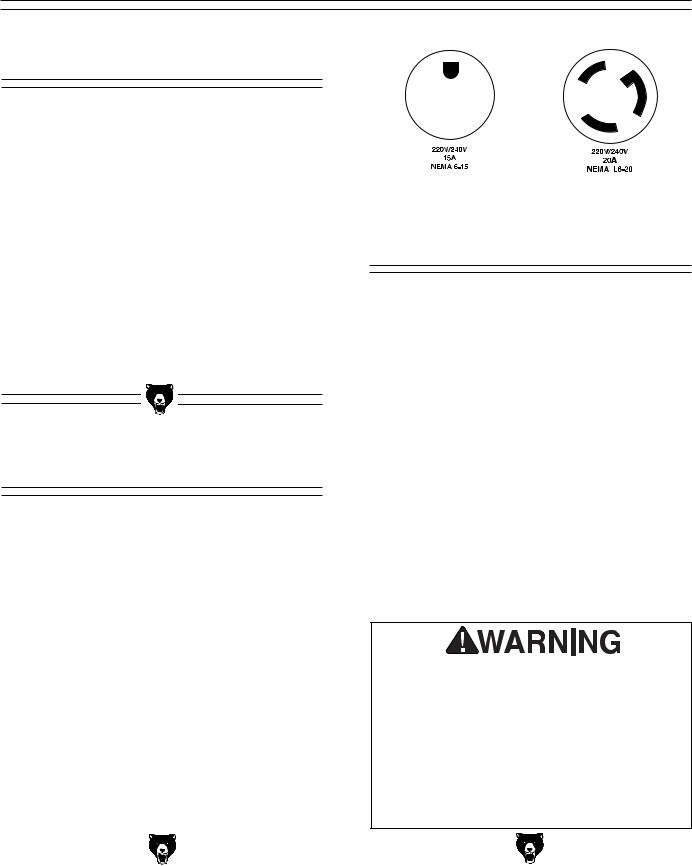
SECTION 2: CIRCUIT REQUIREMENTS
220V/110V Operation
The Model G1140 has a dual-voltage 11⁄2 HP, 1720 RPM motor which has been pre-wired for use in a 220V single phase circuit. The cord set enclosed does not have a plug as the style of plug you require will depend upon the type of service you currently have or plan to install. If you will be installing a new receptacle and plug, we recommend either of the styles shown in Figure 1. Note that you have the choice between simple plug-in and twist-lock plug styles.
Should you prefer to utilize the 110V capability, a wiring diagram is provided near the back of this manual showing the wiring changes needed. Operating at 110V will also require installing a grounded plug.
Circuit Load
The Model G1140 will draw approximately 8 amps at 220V and 16 amps at 110V. Circuit protection when operating at 220V should be on a breaker rated at 15 amps or a fuse rated at 20 amps. At 110V a 20 amp slow-blow fuse or breaker should be used. Fusing at amperage ratings higher than these will not adequately protect the motor from high heat caused by overloading. You are cautioned that equipment returned to us for service that shows evidence of being overfused will be repaired or replaced totally at the customer’s expense, regardless of the present warranty status.
Be aware that other machines operating on the same circuit simultaneously will also add load which can cause the circuit protection system to trip.
|
Standard |
Locking |
||
|
|
|
|
|
|
|
|
|
|
|
|
|
|
|
Figure 1. Two typical outlet/plug configurations.
Grounding
In the event of a malfunction or breakdown, grounding provides a path of least resistance for electric current to reduce the risk of electric shock. This tool is equipped with an electric cord having an equipment-grounding conductor which must be properly connected to a grounding plug. The plug must be inserted into a matching outlet that is properly installed and grounded in accordance with all local codes and ordinances.
Improper connections of the electrical-grounding conductor can result in risk of electric shock. The conductor with green or green and yellow striped insulation is the electrical-grounding conductor. If repair or replacement of the electric cord or plug is necessary, do not connect the equipment grounding conductor to a live terminal.
This equipment must be grounded. Verify that any existing electrical outlet and circuit you intend to plug into is actually grounded. If it is not, it will be necessary to run a separate 12 A.W.G. copper grounding wire from the outlet to a known ground. Under no circumstances should the grounding pin from any threepronged plug be removed. Serious injury may occur.
|
|
|
|
|
|
|
|
|
|
|
|
|
|
-4- |
|
|
|
|
|
G1140 Edge Sander |
|
|
|
|
|
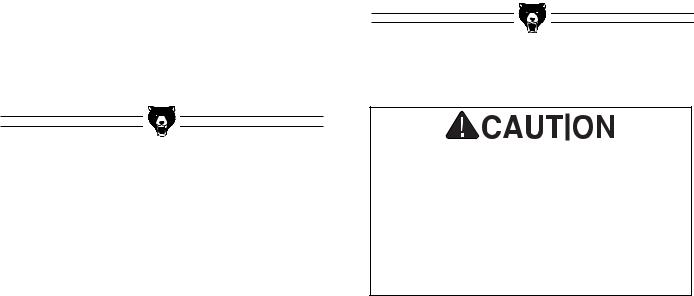
Extension Cords |
|
Wiring Diagram |
|
|
|
|
|
|
We do not recommend the use of extension cords on 220V equipment. It is much better to arrange the placement of your equipment and the installed wiring to eliminate the need for extension cords. Should it be necessary to use an extension make sure the cord is rated Hard Service (grade S) or better. Refer to the chart in Section 1: Safety Instructions to determine the minimum gauge for the extension cord. The extension cord must also contain a ground wire and plug pin. Always repair or replace extension cords when they become worn or damaged.
Your G1140 machine comes pre-wired for 220 volt operation. A wiring diagram is provided at the back of this manual should it be necessary to repair or revise the wiring. Always utilize a qualified electrician when doing any electrical work on this equipment.
We have covered some basic electrical requirements for the safe operation of your Edge Sander. These requirements are not necessarily comprehensive. You must be sure that your particular electrical configuration complies with local and state codes. Ensure compliance by checking with your local municipality or a licensed electrician.
G1140 Edge Sander |
-5- |
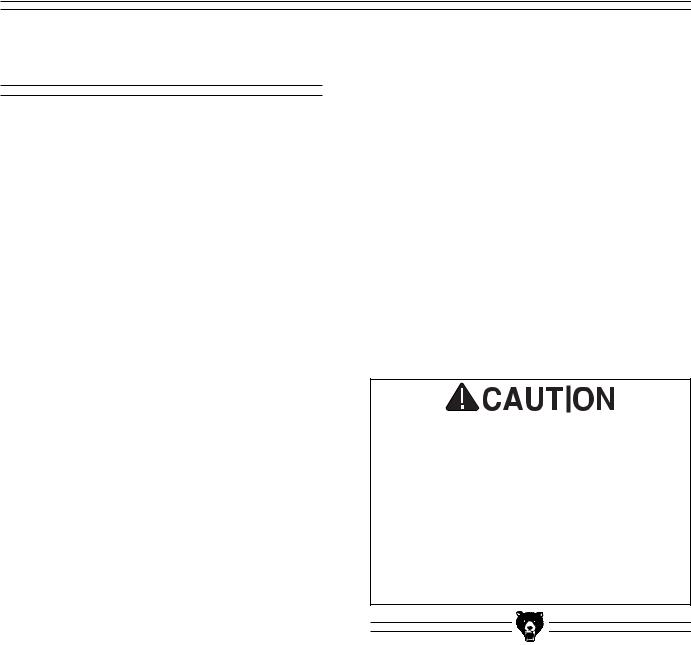
SECTION 3: GENERAL INFORMATION
Commentary
We are proud to offer the Grizzly Model G1140 Edge Sander. The Model G1140 is part of a growing Grizzly family of fine woodworking machinery. When used according to the guidelines set forth in this manual, you can expect years of troublefree, enjoyable operation and proof of Grizzly’s commitment to customer satisfaction.
The Model G1140 is intended for home and medi- um-duty professional use. This sander features a 1,720 RPM, 11/2 HP capacitor-start motor, mechanical ON/OFF switch, 4'' dust port and a cast iron working table. All running parts utilize shielded ball bearings, which require no lubrication for the life of the bearings.
We are also pleased to provide this manual with the Model G1140. It was written to guide you through assembly, review safety considerations, and cover general operating procedures. It represents our effort to produce the best documentation possible. If you have any comments regarding this manual, please write to us at the address below:
Grizzly Industrial, Inc.
C/O Technical Documentation
P.O. Box 2069
Bellingham, WA 98227-2069
Most importantly, we stand behind our machines. If you have any service questions or parts requests, please call or write us at the location listed below.
Grizzly Industrial, Inc.
1203 Lycoming Mall Circle
Muncy, PA 17756
Phone: (570) 546-9663
Fax: (800) 438-5901 E-Mail: techsupport@grizzly.com Web Site: http://www.grizzly.com
The specifications, drawings, and photographs illustrated in this manual represent the Model G1140 as supplied when the manual was prepared. However, owing to Grizzly’s policy of continuous improvement, changes may be made at any time with no obligation on the part of Grizzly. Whenever possible, though, we send manual updates to all owners of a particular tool or machine. Should you receive one, we urge you to insert the new information with the old and keep it for reference.
To operate this, or any power tool, safely and efficiently, it is essential to become as familiar with its characteristics as possible. The time you invest before you begin to use your Model G1140 will be time well spent. DO NOT operate this machine until you are completely familiar with the contents of this manual. Make sure you read and understand all of the safety procedures. If you do not understand something, DO NOT operate the machine.
-6- |
G1140 Edge Sander |
